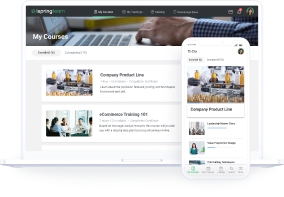How to Create Training Materials That Drive Employee Success

From onboarding to compliance training, L&D teams need to create top-class employee training materials in a timely manner. This is no easy feat, especially in a fast-paced corporate setting. Fortunately, the right tools and preparation can take the headache out of this.
Whether you’re an L&D sage of Yoda-like stature or a training newbie still learning the ropes, in this article, we’ll tell you everything you need to know about developing training materials.
- A training material explained
- A step-by-step guide to creating training materials
- Examples of training materials
- FAQ on creating eLearning content
What Are Training Materials?
Training materials are the core elements of any training program. Essentially, they are the contents that comprise it.
Training materials can come in many different formats, including digital or printed items. Each piece of content has a specific learning goal or desired outcome. Thus, they are usually combined to create a program or learning path. We’ll explore the main kinds of employee training materials later in this article.
What Is the Importance of Training Materials?
Training materials are essential for effective learning and professional development in a company. There are several important reasons to have good learning content:
- Clarity and consistency. Effective training materials provide a clear and consistent source of information for employees. They ensure that everyone receives the same information, which leads to a more standardized learning experience. For example, employee handbooks and training manuals provide uniformity in onboarding new hires.
- Accessibility and reference. Training materials can be a valuable resource for learners to refer back to when they need to refresh their knowledge and receive guidance. For instance, in a sales training program, having materials on sales techniques and products can help sales professionals refresh their memory before approaching a client.
- Efficiency and expediency. Well-designed training materials can save time and effort for both the trainers and the learners. Instead of having to repeat the same information over and over, trainers can simply direct learners to the relevant materials. This allows for a more efficient use of everyone’s time.
How to Create Training Materials for Employees
Creating training materials can seem daunting. Not only do they need to be engaging and effective, but they have to keep up with the needs and goals of the business. Building impactful training materials in-house allows L&D professionals to adapt to business changes and keep training up to date.
Here’s a step-by-step guide to creating training materials that learners will enjoy.
Step 1. Define objectives
The first step is to set clear learning goals and objectives. Defining objectives for each training material will ensure that it achieves the desired learning outcome. Plus, it makes it easier to remove irrelevant content, thereby streamlining the creation process.
When it comes to establishing an objective for your training material, consider the following questions:
- Who is your audience?
- What business goal is the training material related to?
- What skills gap are you trying to fill?
- What is the desired learning outcome?
It’s important to establish concrete answers to these questions before you begin writing the content. The answers will act as a North Star, guiding you through the entire training material development process and keeping your objectives in sight.
Step 2. Review existing training material
Next, get to know the learning content that’s currently available. An up-to-date inventory of all your existing materials will create opportunities for you to reuse, repurpose, or redo the content. This will save you valuable time and resources, and enable you to pinpoint training gaps.
Keep an eye out for obsolete content, issues with the training materials, and inaccuracies. The best way to determine the effectiveness of the material is to gather feedback about how it performed. This information will help you build more effective content in a shorter time frame.
To evaluate current training materials properly, ask these questions:
- How is training currently being conducted?
- What (if any) training materials do we currently have on this topic?
- What type of training resources are they (videos, training manuals, PowerPoint presentations, etc.)?
- Is all relevant information covered in the existing material?
- Is the learning content outdated?
- Are there any mistakes or are major changes needed?
- Are the training materials engaging and didactic?
- How successful was the previous training? What needs to be improved?
Step 3. Design a training plan
It’s now time to devise a training plan that is an outline of all the learning content you will create and how it all fits together. It’s an essential part of the development process, providing a bird’s-eye view of all training activities and resources in the business.
Start off with a general outline. Think of it like a jigsaw puzzle: at this stage, you simply want to understand how everything fits together to see the big picture. This could be as simple as a spreadsheet documenting all employee training programs and the corresponding training materials for each one. Here’s a sample sales training plan for new employees:
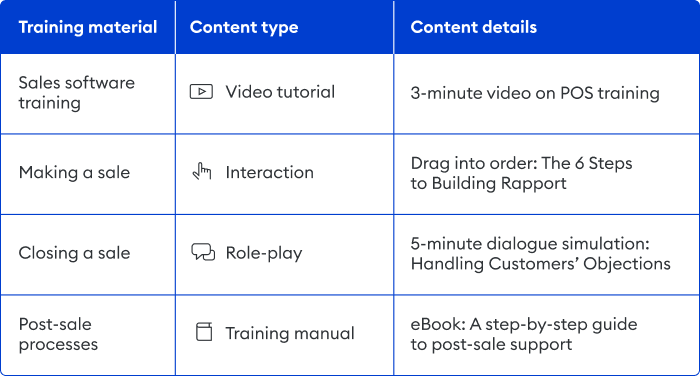
Also read → Retail Sales Training – How to Move It Online
Step 4. Choose an authoring tool
Now let’s turn our attention to how to develop training materials. For most types of digital learning materials, you’ll need a content authoring tool. It helps you create digital training materials and convert them into an eLearning format. This could take the form of online courses, assessments, video lectures, role-plays, etc.
With iSpring Suite, you can create effective training material for every type of learning scenario. From role-play simulations to interactive quizzes, it comes with a range of templates to help kick-start the development process. As a PowerPoint-based tool, first-time authors can pick it up in minutes. Moreover, there is an extensive built-in content library that provides over 89,000 preset slide templates, backgrounds, and characters to bring your training materials to life in no time.
iSpring Suite
Fully-stocked eLearning authoring toolkit for PowerPoint. No training required to start!
Step 5. Create your training material
Once you have your outline and a content creation tool, you can get into the nitty-gritty. Zoom in and focus on each training material. At this stage, you should concentrate on the details, such as creating a script for videos and developing a detailed outline for quizzes and training manuals.
Writing high-quality training materials is enjoyable and rewarding, but there’s a lot to think about. Whether you’re a seasoned pro or a complete beginner, it’s always a good idea to start by creating a checklist of the entire creation process. This will prevent you from missing important steps.
Our comprehensive eLearning guide details how to create training material with iSpring Suite. It covers the nuts and bolts of the development process, so you can get started immediately.
Step 6. Test it in the field
Feedback is the best way to ensure your training materials are ready to be shared. Ideally, ask a group of testers from different areas of the company for their feedback. In this way, you will gain valuable insight from a range of perspectives and backgrounds.
Testing training materials in the field will spotlight issues in the content, such as unclear language or information overload. To streamline the feedback process, ask testers the following questions:
- Is the learning material interesting and engaging?
- Is the content clear and easy to understand?
- Were there any points at which you felt confused? Please elaborate.
- Did you find the training materials relevant to your daily work?
- Did the training offer you opportunities to apply what you learned?
- How can the training material be improved?
Step 7. Deliver the training material
Congratulations, you now know how to create educational content! But, there’s still the small matter of delivering training materials. That’s where a learning management system (LMS) comes in.
An LMS is an essential eLearning tool that allows you to deliver, manage, and track corporate training. All you have to do is upload your training material, organize it into a training course or learning path, and assign it to the correct audience. What’s more, L&D professionals can automate all training management tasks through the LMS to save valuable time and resources.
With the iSpring Learn LMS, you can upload all types of training materials to build online courses or personalized learning tracks. The robust reporting feature allows you to extract custom reports to track learner activity and monitor training outcomes. Moreover, the mobile app gives employees the freedom to learn whenever and wherever they want.
iSpring Learn LMS
Automate corporate training and improve employee performance.
Examples of Training Materials
With so many options, it can be tough to choose the best content type. To inspire you, we’ve gathered some examples of training materials that we like (all made using iSpring Suite).
1. Online courses
An online course is a self-paced training program delivered via digital resources. It’s usually made up of different training materials that all connect together to train learners on a topic. These training modules could include slides with text, multimedia, interactions, and quizzes.
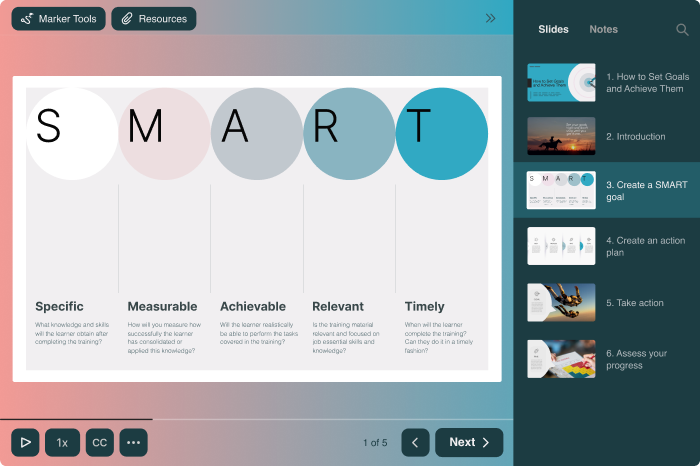
Use cases
Training courses are often used in corporate training to onboard new employees, deliver compliance training, or as components of continuous training programs. They are particularly useful if your organization:
- Has existing training materials, such as PDFs, presentations, and job aids that you want to transform into an online course
- Is rolling out a new product or service and needs to train staff quickly
- Wants to automate or scale employee onboarding
- Needs to move training online on a time crunch
How iSpring can help
There are two things that you want to avoid when creating courses:
- Boring your learners with dull impersonal content
- Spending too much time on the creation process
iSpring can help you sidestep both of these pitfalls. Avoid dull online courses by adding interactive elements to your slide content in iSpring. You simply need to import your existing training materials and inject some life into them with animations, transitions, multimedia, and interactive practice exercises.
To add a personal touch and evoke an emotional connection between the learner and the course, iSpring Suite allows you to create custom characters and add them to your slides. Make them appear to be related to the course topic, provide a storytelling atmosphere, and they can accompany the learner throughout the course, creating an effect of actual communication.
The simple PowerPoint-based interface makes it quick and easy to build captivating courses with no previous experience. Here’s an example of an engaging online slide-based course made using the iSpring Suite authoring toolkit.
2. Quizzes
Quizzes (assessments) are key in online learning. They not only allow you to check learners’ knowledge, but they are also interactive and show learners their progress. This breaks up the monotony of the training and motivates learners to actively participate. Plus, we all pay more attention when we know a test is coming.
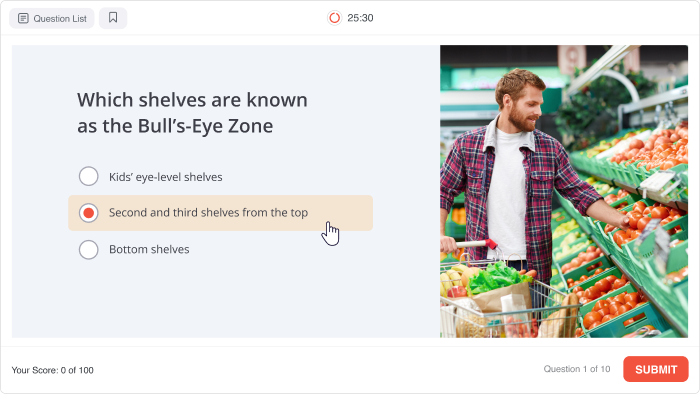
Use cases
Quizzes and assessments can be used in a number of ways. You can sprinkle them throughout an online course to check learners’ knowledge regularly or add a large quiz as a formal final assessment. In short, a quiz can be added at different stages of a training to reinforce learning and engage users.
Here’s an example of the merchandising quiz that encourages learners to interact, matching definitions and dragging merchandise to the correct shelves.


3. Training videos
Training videos engage learners more than any other content type. They are short videos that educate employees on a wide range of topics.

Use cases
Videos can be used as standalone learning content or embedded in courses, making them a flexible option for employee learning. Plus, there are several types of video content to choose from, including:
- Lecture captures – recordings of live training sessions or presentations
- Software tutorials – capture the instructor’s computer screen as they demonstrate how to use software
- Talking head videos – usually webcam recordings of an instructor explaining a training topic
4. Role-plays
Role-play simulations put trainees in real-world scenarios, giving them a chance to practice in a risk-free environment. As such, they can build their confidence and develop their skills without impacting client relations. Most role-plays use branching scenarios to show the consequences of each decision. This teaches employees the outcomes of their actions in a safe space, propelling the learning curve.

Read also → Role-play Scenarios for Customer Service Training
Use cases
Role-plays are perfect for training on:
- Sales
- Customer service
- Negotiation
- Other client-facing situations that call for a one-to-one interaction
Here’s a great example of how to train sales staff using real-life scenario-based training.
5. Flipbooks
Flipbooks are an excellent and underused training tool. They are essentially eLearning longreads that are created by converting training materials that are in PDF, Word, or PowerPoint files into interactive eLearning courses. That way, you can upload them to your learning management system and track how many employees have studied them. They’re a great way to transform existing training documents into digital training materials, making underutilized corporate documents accessible to employees.
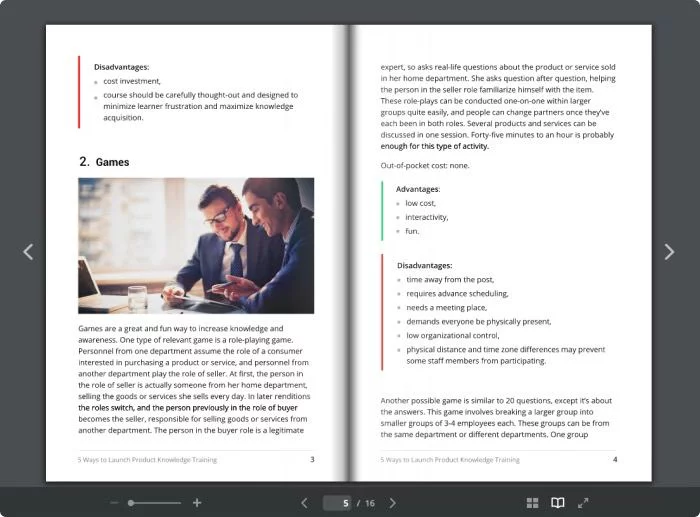
Use cases
Flipbooks are a great way to move training manuals online and train employees on:
- Department policies
- Standard operating procedures
- Step-by-step processes
6. Interactive pages
An interactive page is a sort of article with headings, chapters, and images that also includes interactive elements like videos, quizzes, and flashcards. This training material is extremely easy to create but can make the training process more exciting and efficient because of the interactive extras.

Use cases
An interactive page is especially useful when you need to organize lots of information and start training quickly.
For example, a head office manager might need to share new tariff information with branches. With all the necessary elements (texts, images, and videos) ready, the manager can create a page in a few hours and share the link with colleagues or export it to a compatible LMS.
With iSpring Suite, you can create interactive pages in minutes because it comes with an AI assistant that streamlines the process. It can generate and revise the text, create an article structure, and generate questions for a quiz.
7. Infographics
Infographics are visual representations of knowledge designed to present complex information quickly and clearly. They combine images, charts, graphs, and other visual elements with minimal text to tell a story. Infographics are popular because they make it easier for people to understand and remember information, especially when there is a lot of data.

Use cases
Infographics can be used in a variety of ways:
- To visually present complex data and statistics
- To explain step-by-step processes or procedures
- To compare different sets of data, products, or concepts
8. Checklists
A checklist typically consists of a list of items with checkboxes next to each item, allowing you to mark them off as you complete them. They can be a helpful way to ensure that nothing is overlooked and that all necessary items are finished.

Use cases
Checklists can be helpful when you need to provide employees with knowledge of step-by-step processes and procedures. They ensure that all important steps are covered and can reduce the likelihood of errors or missed steps.
What to Include in Training Materials
Here, our focus will be on the most popular training materials — online courses. These courses should have the following key elements:
- Learning objectives. Outline the training goals clearly, including what participants should be able to do after completing the training.
- Content outline. Break down the learning content into modules or sections, with clear headings and subheadings to help organize the material.
- Visual aids. Include relevant images, diagrams, and charts to enhance understanding and engagement.
- Activities and exercises. Incorporate interactive elements such as case studies, role-plays, or knowledge checks to reinforce learning.
- Assessments. Include online quizzes to measure participants’ understanding and retention of the material.
- Resources. Provide additional reading materials, references, or links to further resources for participants to allow them to continue learning even after the training has been completed.
- Clear instructions. Ensure that the training materials provide clear, step-by-step instructions for participants to follow.
- Real-life examples. Incorporate practical examples and real-life scenarios to demonstrate how the training content applies in a relevant context.
- Accessibility considerations. Ensure that the training materials are accessible to all participants, including those with disabilities, by using accessible formats and different learning styles.
FAQ
Here are the most frequently asked questions on how to create training materials for eLearning.
1. What tools do I need in order to develop training materials and share them with employees?
You need two kinds of training software:
- A content authoring tool to develop effective training materials, such as courses, interactive units, quizzes, and role-plays.
- A learning management system (LMS) to store, deliver, and manage training materials. This will also allow you to track learners’ progress through detailed analytics and reports.
2. What are some common types of training materials?
You can offer multiple delivery methods, including instructor-led training (ILT), virtual classrooms, online learning (eLearning), blended learning, and mobile learning (mLearning). But in the context of eLearning, the most common types of learning content include:
- Online courses
- Videos
- Assessments
- Role-plays
- Digital job aids
3. Are there any best practices for writing great training materials?
Yes, there are some golden rules when developing training materials. Here are a few of our favorite tips to make content as engaging as possible:
- Write for your audience, their job role, and level of expertise
- Use examples and storytelling to clarify complex topics
- Utilize scenario-based learning to train on real-life job situations
- Write in short, simple sentences; avoid jargon
- Break training material up into small, digestible chunks
- Use visual aids to make training materials more appealing
In Closing
We hope these fundamentals of crafting effective training materials have provided you with the know-how and inspiration to build more effective eLearning content. If you still haven’t tried iSpring Suite, start your 14-day free trial today. It will let you build compelling online training courses in no time.

